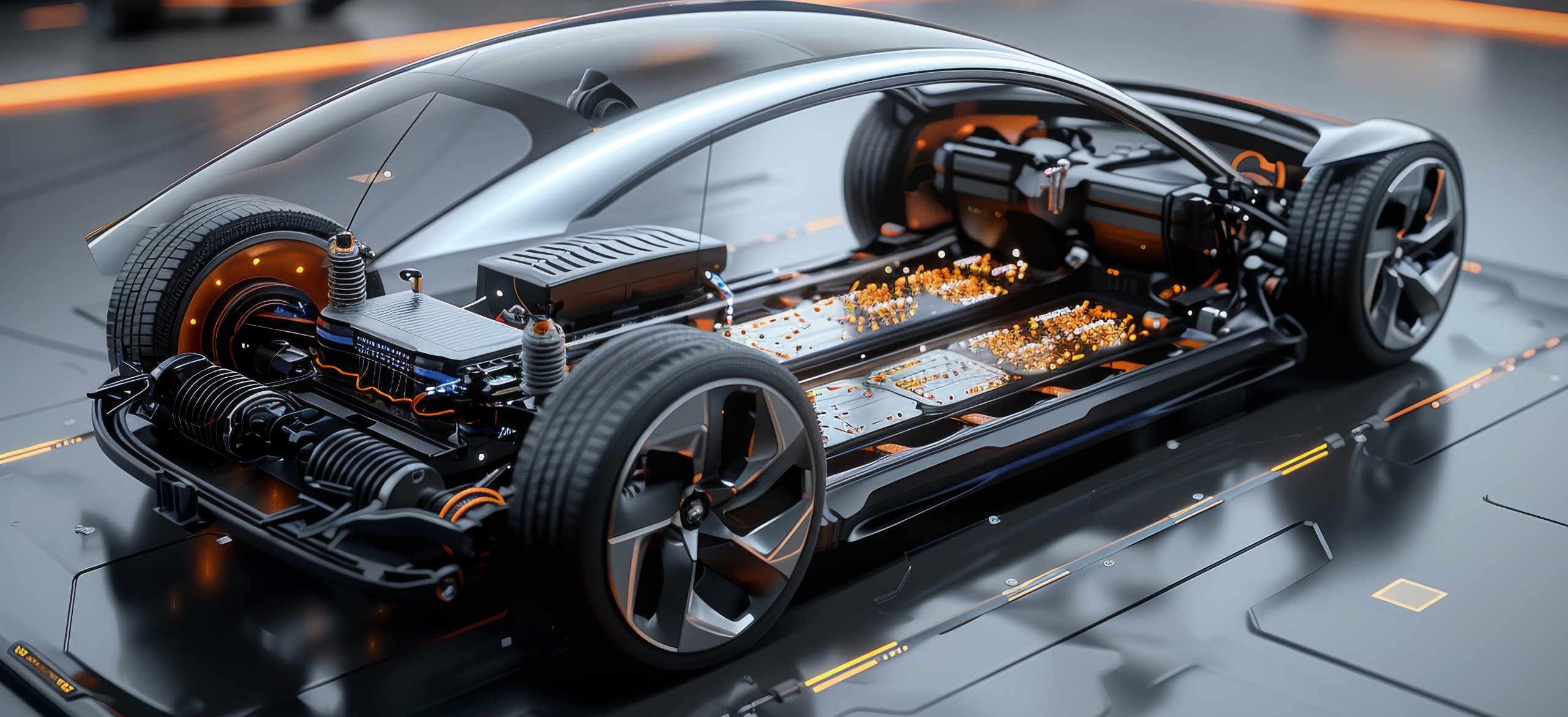All electric and electronic devices automatically generate electromagnetic energy (represented in waveform) during their operation—particularly those characterized by high-speed switching. In vehicles, machines, and other equipment that comprise electric power sources, the electromagnetic energy generated by different components and subsystems can affect each other.
This electromagnetic interference (EMI) may result in performance issues (e.g., voltage spikes), malfunction, or failure. As a result, original equipment manufacturers (OEMs) must take steps to mitigate EMI and ensure their vehicles, machines, and equipment don’t contribute to additional downtime, maintenance costs, or worker safety issues. In this article, we’ll examine EMI more closely, along with techniques OEMs can utilize to mitigate its occurrence.
What is EMI?
Electromagnetic energy is a phenomenon that results from the relationship between electrical flows and magnetic fields. Whenever and wherever one exists, so does the other; lightning and solar flares, generators and radios—all of these create electromagnetic energy.
Of course, batteries and battery chargers also generate this energy.
When multiple electric or electronic devices are in close enough proximity, the electromagnetic energy they generate may interfere with the operation of those devices (e.g., interrupting circuits). This is referred to as electromagnetic interference or, colloquially, “noise.”
Types of EMI
EMI generally falls into three categories:
- Radiated EMI – Occurs when radio frequencies are produced by the components or subsystem, generally over longer distances.
- Conducted EMI — Occurs when there is a direct connection between the EMI’s “source” (i.e., the generating component, subsystem, or device) and its “receiver” or “victim” (i.e., the impacted component, system, or device), such as during power transmission (e.g., on-board battery charger to the battery).
- Coupled EMI – Occurs when components or subsystems operate in close proximity (e.g., parallel wires).
EMI’s Importance and Impact
Complex systems with multiple electronic and electric components and subsystems—such as vehicles and machines—may amplify, focus, or channel electromagnetic waves in unpredictable ways that exacerbate EMI and its effects. Operators may experience effects from more radio static and data corruption to dangerous voltage spikes and disabled components and subsystems.
And those components and subsystems will be responsible for vehicles, machines, or equipment operating as intended and operators’ safety—particularly if malfunctions elevate hazards substantially (e.g., moving blades on outdoor power equipment (OPE), motive applications traveling at higher speeds, battery charging). While on-board chargers offer operators and fleet managers significant benefits, they do add more potential EMI.
Moreover, electromagnetic energy’s impact on devices is stronger over shorter distances. When sources and receivers operate within close proximity—and without using mitigation techniques—more interference occurs.
Therefore, the engineering challenges OEMs face when designing and constructing electric vehicles and machines become more complex as an inherent result of using smaller and more powerful components and subsystems. That’s one trade-off when building more compact products.
EMI Regulations
Because of the operating and health issues associated with electromagnetic energy, governments require products to comply with regulations limiting emissions.
For example:
- US and Canada – Manufacturers must follow the Federal Communications Commission’s (FCC) requirements specified under Title 47, Part 15. The FCC further divides EMI requirements into Class A (i.e., commercial or industrial applications) and Class B (i.e., residential applications), with stricter limits for the latter.
- Europe – Manufacturers must follow Directive 2014/30/EU for general purposes and UN ECE R10 for automotive applications, respectively.
Compliance (typically denoted by an official mark) may require methods like different frequency selections and shielding techniques to adhere to electromagnetic emissions requirements.
EMI Recommendations for EV Manufacturers
Whenever OEMs source electric and electronic components or subsystems, they should keep the following recommendations in mind:
- Choose components and subsystems that comply with specified EMI standards for the applicable market.
- Ensure partners achieve compliance via appropriate testing procedures (e.g., FCC, IEC, CISPR).
- Test components and subsystems often and early during design stages.
- Perform in-house pre-compliance EMI measurement of the final product after installing all components.
- Consult with the supplying partner about component and subsystem design, engineering, manufacturing, and installation recommendations.
-
Be flexible with design and engineering, such as:
- Routing for wires and cables
- Component and subsystem mounting configuration
- Cable size, construction, and material
- Adding shielding, grounds, EMI filters
How to Mitigate EMI
OEMs and their partners can utilize several techniques for minimizing EMI. Some of the most common include:
- Wire routing and selection
- Shielding and grounding
- EMI filters (also known as ferrite “beads,” “blocks,” or “chokes”)
Wire Routing and Selection
Wires and cables—particularly when left loose or in loops—both emit and can suffer from exposure to electromagnetic waves. OEMs should determine routing configurations that run as directly and as far away from potential EMI sources as possible. Again, the proximity between an EMI source and receiver affects the interference’s severity.
Additionally, OEMs should choose appropriate AC cord types and gauges.
Shielding and Grounding
Wires that cannot be routed away from EMI sources must be sufficiently shielded to mitigate interference. This may involve:
- A “drain wire” running alongside bundled wires
- Aluminum shielding around the bundle
- Metal braid (primarily copper) around the aluminum shielding
Non-wire or cable components and subsystems can also be shielded with metal boxes, wraps, or other types of covers.
However, to be effective, all shields must be connected to a ground point (e.g., frame rails). Similarly, EMI-generating components and subsystems should be mounted to the frame.
EMI Filters
EMI filters constructed from ferrite (a magnetic ceramic material) will help reduce both EMI generation and receipt by blocking high-frequency emissions and dissipating the energy as heat. Filters commonly resemble a small cylinder clamped around part of a wire or cable—sometimes on the outside of insulation—or a small box (e.g., inline filters).
Ensure Proper EMI Control with Delta-Q Technologies
OEMs that partner with Delta-Q Technologies to outfit their electric vehicles and machines with on-board battery chargers can trust that the devices comply with global EMI requirements.
Delta-Q Technologies’ chargers—such as the XV3300—have earned FCC and UN ECE R10 compliance. And our industry-leading experts will help OEMs determine and account for other EMI mitigation techniques where chargers integrate with larger electrical systems, along with measuring products’ total emissions.
Sources:
Tech Target. electromagnetic interference (EMI). https://www.techtarget.com/searchmobilecomputing/definition/electromagnetic-interference
UNECE. 06 series of amendments to UN Regulation No. 10 (Electromagnetic compatibility). https://unece.org/fileadmin/DAM/trans/main/wp29/wp29regs/2019/E-ECE-324-Add.9-Rev.6.pdf
EUR-Lex. Directive 2014/30/EU of the European Parliament and of the Council on the harmonisation of the laws of the Member States relating to electromagnetic compatibility. https://eur-lex.europa.eu/legal-content/EN/TXT/?uri=CELEX:32014L0030
Code of Federal Regulations. Title 47 Telecommunication. https://www.ecfr.gov/current/title-47/chapter-I/subchapter-A/part-15?toc=1
Magnetic Mags. Tech Tip: Ferrite Bead Versus Inductor — All You Need to Know from Allied Components International. https://magneticsmag.com/tech-tip-ferrite-bead-versus-inductor-all-you-need-to-know-from-allied-components-international/





